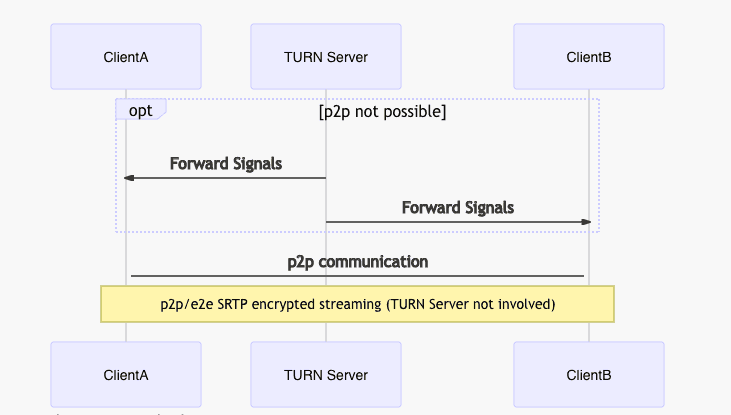Introduction
We will install a basic TURN/STUN server with coturn. The TURN Server is a VoIP media traffic NAT traversal server and gateway. It can be used as a general-purpose network traffic TURN server and gateway, too.
The basic concept of TURN
Example projects which use TURN/STUN:
If you self-host one of these applications you can, for example, use your own TURN/STUN server there.
Prerequisites
- At least a small virtual server, e.g. Cloud Server CX23, with a root shell
- Basic knowledge about linux
Assumptions
- Domain:
example.com - Server IPv4:
10.0.0.1 - Server IPv6:
2001:db8:1234::1 - Client public IPv4:
78.47.166.55 - Client private IPv4:
192.168.0.10
Step 1 - Setup DNS records
General DNS records:
turn.example.com. 14400 IN A 10.0.0.1
turn.example.com. 14400 IN AAAA 2001:db8:1234::1
stun.example.com. 14400 IN A 10.0.0.1
stun.example.com. 14400 IN AAAA 2001:db8:1234::1
@ IN NAPTR 10 0 "s" "RELAY:turn.udp" "" _turn._udp.example.com.Following DNS records should be used if you only install one TURN/STUN server:
_stun._udp.example.com. 14400 IN SRV 5 0 3478 turn.example.com.
_stun._tcp.example.com. 14400 IN SRV 5 0 3478 turn.example.com.
_stuns._tcp.example.com. 14400 IN SRV 5 0 5349 turn.example.com.
_turn._udp.example.com. 14400 IN SRV 5 0 3478 turn.example.com.
_turn._tcp.example.com. 14400 IN SRV 5 0 3478 turn.example.com.
_turns._tcp.example.com. 14400 IN SRV 5 0 5349 turn.example.com.For best performance and fail-safe you should have at least two TURN/STUN servers. We slightly need to change the DNS records for two:
_stun._udp.example.com. 14400 IN SRV 5 50 3478 turn1.example.com.
_stun._udp.example.com. 14400 IN SRV 10 50 3478 turn2.example.com.
_stun._tcp.example.com. 14400 IN SRV 5 50 3478 turn1.example.com.
_stun._tcp.example.com. 14400 IN SRV 10 50 3478 turn2.example.com.
_stuns._tcp.example.com. 14400 IN SRV 5 50 5349 turn1.example.com.
_stuns._tcp.example.com. 14400 IN SRV 10 50 5349 turn2.example.com.
_turn._udp.example.com. 14400 IN SRV 5 50 3478 turn1.example.com.
_turn._udp.example.com. 14400 IN SRV 10 50 3478 turn2.example.com.
_turn._tcp.example.com. 14400 IN SRV 5 50 3478 turn1.example.com.
_turn._tcp.example.com. 14400 IN SRV 10 50 3478 turn2.example.com.
_turns._tcp.example.com. 14400 IN SRV 5 50 5349 turn1.example.com.
_turns._tcp.example.com. 14400 IN SRV 10 50 5349 turn2.example.com.Do not forget to setup DNS records (A and AAAA) for turn1.example.com and turn2.example.com as mentioned above.
Theoretically you could also deploy a second A and AAAA record for turn.example.com and stun.example.com but this is not the recommended way.
Step 2 - Installation
First, we will need to install coturn on our server:
apt-get update
apt-get install coturnFor the moment, we will stop coturn:
systemctl stop coturnStep 3 - Configuration
In order to enable the TURN server, open the file /etc/default/coturn and remove the # in front of TURNSERVER_ENABLED=1.
The configuration file is located at /etc/turnserver.conf. First, we move the original version of this file using:
mv /etc/turnserver.conf /etc/turnserver.conf.origThen we open/create /etc/turnserver.conf in an editor of our choice and paste the following configuration:
listening-port=3478
tls-listening-port=5349
fingerprint
lt-cred-mech
use-auth-secret
static-auth-secret=replace-this-secret
realm=turn.example.com
total-quota=100
stale-nonce=600
cert=/etc/letsencrypt/live/turn.example.com/cert.pem
pkey=/etc/letsencrypt/live/turn.example.com/privkey.pem
cipher-list="ECDHE-RSA-AES256-GCM-SHA512:DHE-RSA-AES256-GCM-SHA512:ECDHE-RSA-AES256-GCM-SHA384:DHE-RSA-AES256-GCM-SHA384:ECDHE-RSA-AES256-SHA384"
no-sslv3
no-tlsv1
no-tlsv1_1
#no-tlsv1_2
dh2066
no-stdout-log
log-file=/var/tmp/turn.log
#log-file=/dev/null
no-loopback-peers
no-multicast-peers
proc-user=turnserver
proc-group=turnserverGenerate the secret by using
sed -i "s/replace-this-secret/$(openssl rand -hex 32)/" /etc/turnserver.confStep 4 - Register Let's Encrypt certificates
We will use certbot from EFF for the Let's Encrypt certificates.
apt-get install snapd
snap install --classic certbot
ln -s /snap/bin/certbot /usr/bin/certbotWith certbot installed, you can now create your certificate.
certbot certonly --standalone --rsa-key-size 4096 -m holu@example.com -d turn.example.comYou will get an email 30 (and 7) days before the certificates expire to holu@example.com.
Step 5 - Start and test the TURN/STUN server
We will start coturn by executing systemctl start coturn. Using systemctl status coturn we can test if coturn is running.
We do not know yet if our configuration was successful but luckily there is a tester available: WebRTC samples Trickle ICE
Remove the default server from the list. The field for “STUN or TURN URI” should look like this:
stun:stun.example.combut you can also use the IP:
stun:10.0.0.1:3478To test SSL/TLS encryption, use port 5349. You cannot test TURN here as the tester does not support.
Next click on Add Server and then on Gather candidates.
The output should look similar to this:
Time Component Type Foundation Protocol Address Port Priority
0.019 1 host 0 UDP 192.168.0.10 41904 126 | 32512 | 255
0.024 1 host 2 TCP 192.168.0.10 9 125 | 32704 | 255
0.027 2 host 0 UDP 192.168.0.10 53438 126 | 32512 | 254
0.030 2 host 2 TCP 192.168.0.10 9 125 | 32704 | 254
0.134 1 srflx 1 UDP 78.47.166.55 41904 100 | 32543 | 255
0.152 2 srflx 1 UDP 78.47.166.55 53438 100 | 32543 | 254
0.153 DoneIf you get a timeout with Not reachable? the connection is probably blocked by a firewall. Check again if the ports 3478 and 5349 for the TURN server are open. Also test if you can reach it from your computer or another server via telnet or nmap.
If everything works as expected, replace log-file=/var/log/turn.log with log-file=/dev/null in your configuration file. This disables IP address logging and is for best privacy.
Conclusion
We now have a working TURN/STUN server. You can replace default TURN/STUN servers in other projects, some of them are mentioned above.
